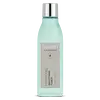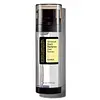What's inside
What's inside
 Key Ingredients
Key Ingredients

 Benefits
Benefits

 Concerns
Concerns

No concerns
 Ingredients Side-by-side
Ingredients Side-by-side

Water
Skin ConditioningButylene Glycol
HumectantPropanediol
SolventGlycerin
HumectantSalvia Hispanica Seed Extract
EmollientSodium Citrate
BufferingChlorphenesin
AntimicrobialHydrolyzed Oats
Skin ConditioningDisodium EDTA
Acetyl Glucosamine
Skin ConditioningCeteth-20
CleansingCitric Acid
BufferingCitrullus Lanatus Fruit Extract
Skin ConditioningDipotassium Glycyrrhizate
HumectantMalpighia Emarginata Fruit Extract
Skin ConditioningLens Esculenta Fruit Extract
Skin ConditioningPyrus Malus Fruit Extract
Skin ConditioningLactobacillus Ferment
Skin ConditioningSodium Hyaluronate
HumectantParfum
MaskingSodium Lactate
BufferingPhenoxyethanol
PreservativeSodium Benzoate
MaskingXanthan Gum
EmulsifyingLecithin
EmollientPotassium Sorbate
PreservativeGluconolactone
Skin ConditioningSodium PCA
HumectantGlyceryl Acrylate/Acrylic Acid Copolymer
HumectantPvm/Ma Copolymer
Emulsion StabilisingSalvia Hispanica Seed Oil
MoisturisingCarrageenan
Glucose
HumectantCeramide NP
Skin ConditioningBeta-Sitosterol
Emulsion StabilisingOenothera Biennis Oil
EmollientPerilla Ocymoides Seed Oil
Skin ConditioningTocopherol
AntioxidantGlycine Soja Oil
EmollientBHT
AntioxidantHelianthus Annuus Seed Oil
EmollientHexyl Cinnamal
PerfumingLimonene
PerfumingWater, Butylene Glycol, Propanediol, Glycerin, Salvia Hispanica Seed Extract, Sodium Citrate, Chlorphenesin, Hydrolyzed Oats, Disodium EDTA, Acetyl Glucosamine, Ceteth-20, Citric Acid, Citrullus Lanatus Fruit Extract, Dipotassium Glycyrrhizate, Malpighia Emarginata Fruit Extract, Lens Esculenta Fruit Extract, Pyrus Malus Fruit Extract, Lactobacillus Ferment, Sodium Hyaluronate, Parfum, Sodium Lactate, Phenoxyethanol, Sodium Benzoate, Xanthan Gum, Lecithin, Potassium Sorbate, Gluconolactone, Sodium PCA, Glyceryl Acrylate/Acrylic Acid Copolymer, Pvm/Ma Copolymer, Salvia Hispanica Seed Oil, Carrageenan, Glucose, Ceramide NP, Beta-Sitosterol, Oenothera Biennis Oil, Perilla Ocymoides Seed Oil, Tocopherol, Glycine Soja Oil, BHT, Helianthus Annuus Seed Oil, Hexyl Cinnamal, Limonene
Snail Secretion Filtrate
Skin ConditioningButylene Glycol
HumectantNiacinamide
Smoothing1,2-Hexanediol
Skin ConditioningBetaine
HumectantPanthenol
Skin ConditioningWater
Skin ConditioningGlycerin
HumectantLimnanthes Alba Seed Oil
Skin ConditioningHelianthus Annuus Seed Oil
EmollientAllantoin
Skin ConditioningCarbomer
Emulsion StabilisingMacadamia Ternifolia Seed Oil
EmollientSodium Polyacrylate
AbsorbentSodium Hyaluronate
HumectantInulin Lauryl Carbamate
Emulsion StabilisingArginine
MaskingArgania Spinosa Kernel Oil
EmollientXanthan Gum
EmulsifyingSodium Surfactin
CleansingEthylhexylglycerin
Skin ConditioningGlutathione
Snail Secretion Filtrate, Butylene Glycol, Niacinamide, 1,2-Hexanediol, Betaine, Panthenol, Water, Glycerin, Limnanthes Alba Seed Oil, Helianthus Annuus Seed Oil, Allantoin, Carbomer, Macadamia Ternifolia Seed Oil, Sodium Polyacrylate, Sodium Hyaluronate, Inulin Lauryl Carbamate, Arginine, Argania Spinosa Kernel Oil, Xanthan Gum, Sodium Surfactin, Ethylhexylglycerin, Glutathione
 Reviews
Reviews

Ingredients Explained
These ingredients are found in both products.
Ingredients higher up in an ingredient list are typically present in a larger amount.
Butylene Glycol (or BG) is used within cosmetic products for a few different reasons:
Overall, Butylene Glycol is a safe and well-rounded ingredient that works well with other ingredients.
Though this ingredient works well with most skin types, some people with sensitive skin may experience a reaction such as allergic rashes, closed comedones, or itchiness.
Learn more about Butylene GlycolGlycerin is already naturally found in your skin. It helps moisturize and protect your skin.
A study from 2016 found glycerin to be more effective as a humectant than AHAs and hyaluronic acid.
As a humectant, it helps the skin stay hydrated by pulling moisture to your skin. The low molecular weight of glycerin allows it to pull moisture into the deeper layers of your skin.
Hydrated skin improves your skin barrier; Your skin barrier helps protect against irritants and bacteria.
Glycerin has also been found to have antimicrobial and antiviral properties. Due to these properties, glycerin is often used in wound and burn treatments.
In cosmetics, glycerin is usually derived from plants such as soybean or palm. However, it can also be sourced from animals, such as tallow or animal fat.
This ingredient is organic, colorless, odorless, and non-toxic.
Glycerin is the name for this ingredient in American English. British English uses Glycerol/Glycerine.
Learn more about GlycerinHelianthus Annuus Seed Oil is the oil derived from the seeds of a Sunflower. Sunflower seed oil is non-fragrant. It is an emollient, meaning it helps to soften the skin.
Sunflower seed oil contains many fatty acids. The fatty acids found in sunflower seeds include (from highest amount to least): linoleic acid, myristic acid, palmitic acid, stearic acid, arachidic acid, oleic acid, and linolenic acid.
These fatty acids help the skin create ceramides. Ceramides play a role in repairing the skin barrier.
Helianthus Annuus Seed Oil helps moisturize the skin. This in turn helps the skin look more rejuvenated and smoother.
Sunflowers are rich in vitamin E.
Historians believe Indigenous cultures of North America domesticated sunflowers before corn. Thus they relied on sunflower oil for a variety of uses. One such use is moisturizing skin and hair.
Sunflower seed oil may not be fungal acne safe. We recommend speaking with a professional if you have any concerns.
Learn more about Helianthus Annuus Seed OilSodium Hyaluronate is hyaluronic acid's salt form. It is commonly derived from the sodium salt of hyaluronic acid.
Like hyaluronic acid, it is great at holding water and acts as a humectant. This makes it a great skin hydrating ingredient.
Sodium Hyaluronate is naturally occurring in our bodies and is mostly found in eye fluid and joints.
These are some other common types of Hyaluronic Acid:
Learn more about Sodium HyaluronateWater. It's the most common cosmetic ingredient of all. You'll usually see it at the top of ingredient lists, meaning that it makes up the largest part of the product.
So why is it so popular? Water most often acts as a solvent - this means that it helps dissolve other ingredients into the formulation.
You'll also recognize water as that liquid we all need to stay alive. If you see this, drink a glass of water. Stay hydrated!
Learn more about WaterXanthan gum is used as a stabilizer and thickener within cosmetic products. It helps give products a sticky, thick feeling - preventing them from being too runny.
On the technical side of things, xanthan gum is a polysaccharide - a combination consisting of multiple sugar molecules bonded together.
Xanthan gum is a pretty common and great ingredient. It is a natural, non-toxic, non-irritating ingredient that is also commonly used in food products.
Learn more about Xanthan Gum